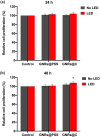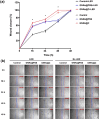Synergistic effect of gold nanorods coated with type I collagen and LED irradiation on wound healing in human skin fibroblast cells
- PMID: 40417166
- PMCID: PMC12096408
- DOI: 10.1039/d4na01072h
Synergistic effect of gold nanorods coated with type I collagen and LED irradiation on wound healing in human skin fibroblast cells
Abstract
Delayed wound healing poses a significant risk to human health, especially when wounds are infected by pathogens. Therefore, the development of effective methods for accelerating wound healing is important. This study investigated the synergistic effect of gold nanorods (GNRs) coated with type I collagen (GNRs@C) combined with light-emitting diode (LED) irradiation on wound healing in scratched human skin fibroblast (HSF) cells. Scratched HSF cells were treated with 3 μg mL-1 GNRs@C, followed by LED irradiation. This combined treatment significantly enhanced cell proliferation, increasing from the control cell base line (scratched HSF cells without any treatment) to 104.08 ± 2.96% and 107.82 ± 3.25% after 24 and 48 h of incubation, respectively. GNRs@C demonstrated superior cellular uptake compared to uncoated GNRs. Notably, complete closure of scratched HSF cells was observed in scratched HSF cells treated with GNRs@C with LED irradiation and then incubated for 40 h. Additionally, the treatment significantly reduced interleukin-6 (IL-6) and tumor necrosis factor-alpha (TNF-α) levels, while upregulating key growth factors, including vascular endothelial growth factor (VEGF) and basic fibroblast growth factor (bFGF). These findings demonstrate the wound healing potential of GNRs@C combined with LED irradiation.
This journal is © The Royal Society of Chemistry.
Conflict of interest statement
There are no conflicts to declare.
Figures











References
-
- Chen H. Shao L. Li Q. Wang J. Chem. Soc. Rev. 2013;42:2679–2724. - PubMed
LinkOut - more resources
Full Text Sources

